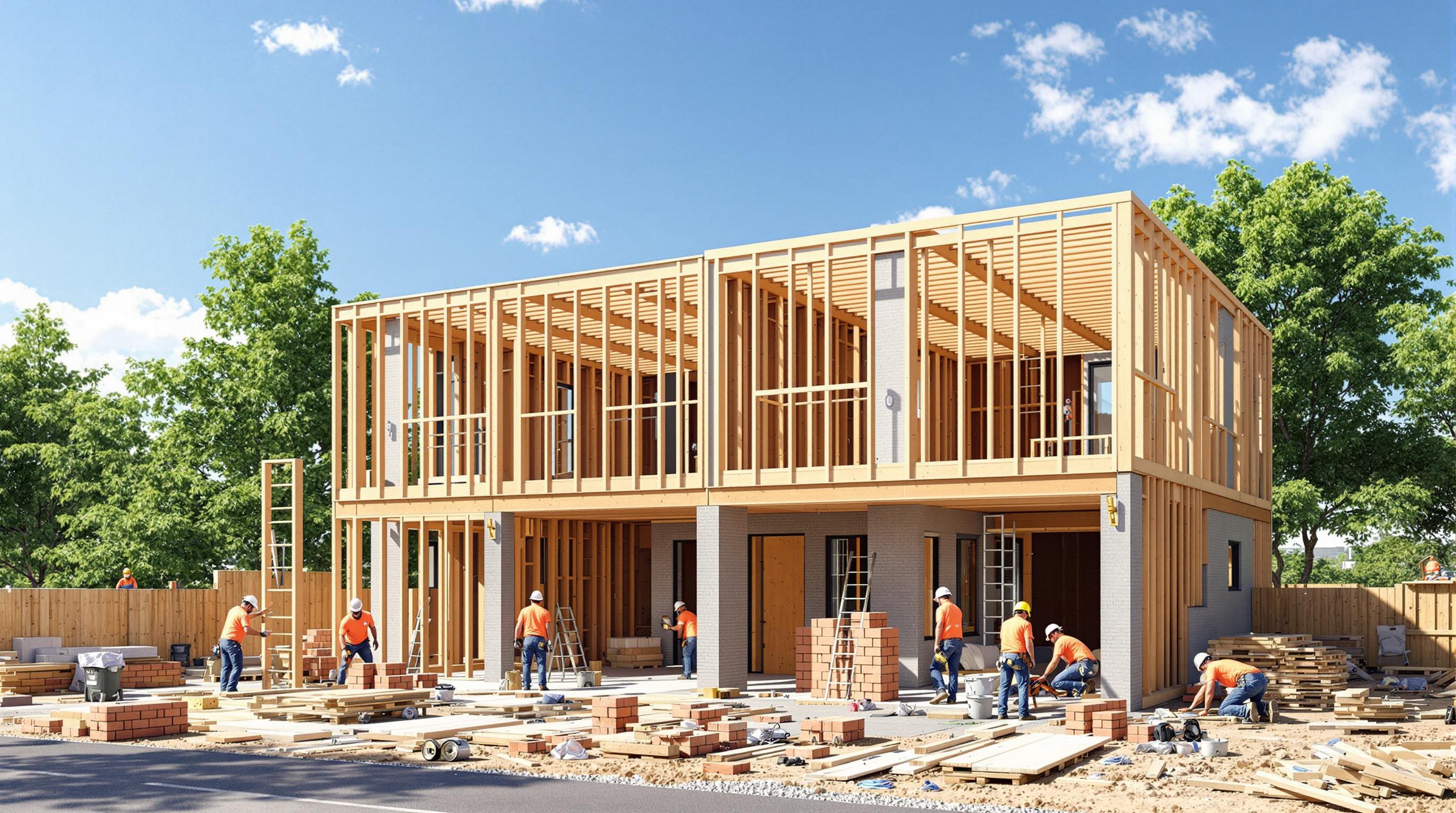Nova Scotia’s climate is tough on homes. From freezing winters to humid summers, and coastal storms to rising sea levels, building a durable home here means planning for extreme weather. Here’s how to protect your investment and stay comfortable year-round:
- Insulation: Use materials like spray foam or cellulose to keep heat in during winter and reduce energy bills.
- Foundations: Prevent damage from freeze-thaw cycles with proper drainage, frost protection, and durable materials.
- Coastal Protection: Near the ocean? Choose marine-grade materials, impact-resistant windows, and elevated designs to handle salt, wind, and storm surges.
- Seasonal Building Tips: Winter construction can save costs, but plan carefully for concrete curing and material protection.
- Storm-Ready Features: Use storm-rated siding, roofing, and sealed building envelopes to withstand high winds and heavy rain.
- Heating Systems: Cold-climate heat pumps work efficiently even at –25°C and save up to 70% on energy compared to traditional systems.
Quick Fact: Sea levels in Nova Scotia could rise by up to 1 metre by 2100, and annual precipitation is expected to increase by 10%. Building weather-resilient homes now can save you from costly repairs later.
Cost vs. Savings: While weather-proofing adds to upfront costs, it reduces long-term energy bills and maintenance. Efficiency Nova Scotia rebates can help offset expenses, including up to $2,000 for heat pumps.
Building a home in Nova Scotia isn’t just about meeting today’s needs - it’s about preparing for the future. Read on for proven strategies to design a home that stands up to the province’s evolving climate.
Building a new home? Consider a Passive House
Nova Scotia Weather Patterns and Building Challenges
Nova Scotia's maritime climate creates unique hurdles for construction, requiring careful planning and adaptation. The province's weather is shaped by its proximity to four major bodies of water: the Gulf of Saint Lawrence, Bay of Fundy, Gulf of Maine, and Atlantic Ocean [1].
Regional Weather Differences
Different parts of Nova Scotia experience varying weather conditions, which influence construction approaches:
| Region | Key Weather Patterns | Building Considerations |
|---|---|---|
| Southern Coast | Milder temperatures, high humidity, frequent fog | Moisture-resistant barriers, corrosion-resistant materials |
| Northern Areas | Harsher winters, Gulf influence | High R-value insulation, durable foundations |
| Coastal Zones | Salt exposure, strong winds | Marine-grade materials, reinforced structures |
| Inland Regions | Greater temperature fluctuations | Flexible building envelope systems |
These variations require tailored solutions to handle moisture, temperature extremes, and coastal conditions effectively.
Weather Damage Prevention
To combat the challenges posed by the climate, specific measures are essential to address freeze-thaw cycles, moisture risks, and coastal impacts.
-
Freeze-Thaw Cycles
Temperature swings around freezing can cause foundation movement and stress on materials. Designs must consider frost penetration and account for expansion caused by these fluctuations. -
Moisture Management
Effective ventilation and moisture barriers are critical to controlling condensation and preventing long-term damage. -
Coastal Challenges
Coastal properties face unique risks from salt exposure, high winds, and rising sea levels. With sea levels projected to rise by up to 1 metre by 2100 [2], homes in these areas should feature elevated foundations and designs resistant to storm surges.
Homes in Nova Scotia need to not only withstand current weather but also anticipate future climate shifts. These considerations lay the groundwork for weather-resilient construction methods, which are explored in the next section.
Weather-Ready Construction Methods
Building a home in Nova Scotia means preparing for a tough climate. The region's weather demands construction techniques and materials that can handle cold winters, heavy precipitation, and coastal conditions. Here's how to ensure your home is up to the challenge.
Cold Weather Insulation Standards
Keeping your home warm during Nova Scotia's winters starts with proper insulation. It not only improves indoor comfort but also helps lower energy bills. Choosing the right materials and installing them correctly is key.
| Insulation Type | Ideal Use | Benefits |
|---|---|---|
| Cellulose | Walls, attics | Retains R-value in cold, fills cavities well, eco-friendly |
| Fiberglass | Between studs, joists | Fire-resistant, affordable, widely available |
| Spray Foam | Gaps, cracks | Excellent air sealing, high R-value per inch |
| Foam Board | Roofs, foundations | Resists moisture, provides structural support |
Focus on insulating these areas: attics with high R-value materials, basement walls with continuous insulation, sealed and insulated crawl spaces, and air barriers installed before insulation. These steps ensure maximum energy efficiency and comfort.
Foundation and Water Management
Nova Scotia's freeze-thaw cycles can wreak havoc on foundations. To protect your home, it's crucial to address foundation stability and water management.
Key strategies include:
-
Soil Preparation
Use coarse granular material around foundations instead of fine-grained soil. This helps with drainage and prevents frost heaving. -
Drainage Systems
Install systems to manage water effectively, such as:- Weep holes at the base of retaining walls.
- Proper grading to direct water away from the home.
- Clean granular backfill materials to improve drainage.
-
Frost Protection
For unheated buildings, footings should extend below the frost line. Heated structures benefit from heat loss that keeps surrounding soil from freezing.
Coastal Building Materials
For homes near the coast, material selection plays a critical role in standing up to harsh conditions like salt air, wind, and moisture.
"For construction contractors, material choice is the first line of defence in a battle against corrosion, humidity, wind, and water." - Faith Munsell, Concrete Contractors, Port Aggregates [3]
Here are some recommended materials for coastal construction:
- Foundations: Use ready-mix or precast concrete to resist salt damage.
- Siding: Opt for fibre cement products that handle moisture well and require little maintenance.
- Structural Elements: Galvanized steel offers strong protection against corrosion.
- Windows: Impact-resistant glass shields against storms and reduces noise.
- Decking: Composite materials perform better than wood in salty environments.
Building in Different Seasons
Seasonal weather changes in Nova Scotia have a direct impact on how materials perform and hold up over time. They also influence construction methods and costs. Knowing how these seasonal factors play out can help in deciding the best time to start a project.
Winter Construction Facts
Building during Nova Scotia's winters is possible with the right planning and techniques. The focus lies on handling materials carefully and protecting them from the cold.
Concrete Work in Cold Weather: To ensure concrete cures correctly, calcium chloride additives and temperature-controlled methods (like insulated blankets) are commonly used. Timing is critical - schedule pours to avoid sudden temperature drops.
"It is true that calcium chloride is added to the concrete mix to accelerate the curing process in cold weather conditions. What is ultimately important however, is that the concrete with additives as compared to concrete without additives is not significantly different in strength, when both are fully cured." - Lynn Delagrange, President, Lynn Delagrange, Inc. [4]
Winter Building Benefits: Winter’s lower humidity helps with lumber drying, keeping kiln-dried framing at around 19% moisture content. Removing snow before it melts protects materials from damage. Plus, scheduling work in the off-season often leads to cost savings.
These winter-specific practices highlight how weather can shape construction timing and strategies.
Weather Effects on Project Timing
Weather conditions throughout the year influence construction schedules and budgets in different ways. Being aware of these effects is crucial for effective planning.
| Season | Advantages | Challenges |
|---|---|---|
| Winter | Off-season scheduling can reduce costs | Equipment delivery issues; concrete curing concerns |
| Spring | Moderate temperatures; longer daylight | Wet ground; higher material costs |
| Summer | Long workdays | High humidity affecting materials; peak pricing |
| Fall | Dry, moderate weather | Shorter daylight hours |
"When the ground is thawing, they don't want any heavy equipment on the roads - anything from sheet rock delivery, concrete, [or] gravel. [As a result], your foundation work is limited and you're not going to get any land development done." - Joe Flynn, Minneapolis/St. Paul division president of David Weekley Homes [5]
Seasonal Planning Tips: Be ready for heavy rain with erosion control measures, plan for freeze-thaw cycles, and factor in seasonal shifts in material prices and labour availability. Using prefinished materials and maintaining proper moisture control can also help protect your project.
sbb-itb-16b8a48
Storm Protection and Long-Term Durability
Storm-Rated Materials
Nova Scotia’s weather can be tough, so choosing materials that stand up to storms and wear over time is crucial.
Siding Options: Inorganic materials like fibre cement and steel log siding are great choices for coastal areas. They resist water damage, fire, and impacts, while also holding up well against salt air and humidity.
Roofing Tips: Composite shingles are a better option for severe weather compared to traditional materials. For proper installation, ensure:
- A high-quality roof cover board is used
- Professional step flashing is installed around penetrations
- Correct underlayment is applied
Sealed Building Envelope: A fully sealed envelope is essential for keeping out moisture and wind:
| Component | Recommended Solution | Key Advantage |
|---|---|---|
| Windows | Storm-rated glass | Handles strong winds and impacts |
| Frame Construction | Insulated Concrete Form (ICF) | Resists fire and mould effectively |
| Air Barriers | Complete seal system | Blocks moisture transfer |
By using these materials, you can ensure better heating efficiency and meet building code requirements.
Heating Systems and Power Backup
Keeping homes warm during outages is just as important as structural durability. In Nova Scotia’s cold climate, reliable heating systems are a must. Heat pump technology has become a go-to solution, with adoption rising from 6% to 21% of households since 2013 [7].
Heat Pump Performance: Modern cold-climate heat pumps work efficiently even at -25°C without needing backup systems [7].
"Heat pumps are critical to Canada's energy transition for several reasons. Heat pumps run on electricity, rather than fossil fuels, making them an important tool in Canada's big switch to clean electricity. They also use up to 70 per cent less energy than conventional home heating technologies, promising savings for homeowners and renters." - Canadian Climate Institute [7]
Backup Power Options: Pairing heat pumps with electrical thermal storage (ETS) systems ensures consistent heating during power outages [6]. This setup not only keeps homes warm but also lowers energy use and operating costs.
Building Code Requirements
To ensure safety and durability, it’s essential to follow updated building codes. Nova Scotia Building Code Regulations align with the National Building Code of Canada 2020 (updated April 1, 2023) [8]. Key requirements include:
- Compliance with storm drainage standards
- Structural wind resistance
- Energy efficiency benchmarks
Local building officials may enforce extra standards based on specific conditions. Homeowners are responsible for securing the necessary permits and meeting all regulations [8]. Hiring qualified professionals familiar with local codes is key to staying compliant and weather-ready.
Weather-Ready Building Costs and Savings
Construction Costs vs. Future Savings
Building a home that can withstand Nova Scotia's weather requires upfront planning and investment, but it pays off in the long run. Since 1980, extreme weather events have doubled[9]. By using durable construction techniques, you can significantly lower future repair costs. Upgrades like better insulation, energy-efficient windows, and advanced heating systems not only protect your home but also cut down on energy bills. Plus, when paired with local rebate programs, these savings become even more appealing.
"Would you rather invest money now for a better home, or burn money in the future in energy bills?" - Ecohome
Available Rebates and Programs
Efficiency Nova Scotia offers rebates to make weather-resistant home upgrades more affordable. Current heat pump rebate options include:
- Up to $400 for mini-split ductless systems
- Up to $2,000 for central systems
- An extra $500 for income-qualified households[10]
For more details, call Efficiency Nova Scotia at 1-877-999-6035[11]. They also provide an interactive home assessment tool to guide you through the process.
Helio Urban Development Price Plans

After applying available rebates, Helio Urban Development offers fixed-price packages that make weather-ready construction manageable and predictable. Starting prices for our packages include essential weather-proofing features:
| Home Type | Starting Price | Weather-Ready Features |
|---|---|---|
| Single-Family | $168/sq.ft | Basic weather resistance |
| Duplex | $175/sq.ft | Enhanced insulation and storm-rated materials |
| Multi-Unit (4-8) | Custom pricing | Full climate-resilient package |
Each package includes expert installation of materials designed to tackle Nova Scotia's unique climate challenges. Our builds exceed minimum code requirements, offering extra protection and peace of mind for years to come.
Conclusion
Building homes in Nova Scotia requires more than just meeting basic standards - durable design and high-quality materials are essential. With climate patterns shifting, construction must account for these changes to ensure homes remain resilient over time [2].
While standard building codes provide a baseline, going beyond them with features like advanced insulation, reinforced foundations, and storm-rated materials offers long-term benefits. Although these upgrades may increase upfront costs, they can significantly reduce expenses in the future, particularly as precipitation and temperature changes are expected to intensify by the end of the century [2].
At Helio Urban Development, we’ve integrated these durable features into our fixed-price packages. This ensures every home we build is equipped to handle Nova Scotia’s evolving climate, reflecting our commitment to construction that lasts.
Preparing for Nova Scotia’s climate isn’t just about handling today’s conditions - it’s about staying ready for future challenges. The evidence highlights that investing in weather-resistant homes safeguards both your property and your peace of mind.
FAQs
What type of insulation is best for homes in Nova Scotia's unpredictable climate?
Choosing the right insulation for your home in Nova Scotia is crucial to ensure comfort and energy efficiency, especially given the province's cold winters, humid summers, and coastal conditions. Here are some great options to consider:
- Cellulose: Made from recycled materials, this eco-friendly option works well in attics and walls. It provides excellent resistance to air infiltration and is both fire- and pest-resistant.
- Fibreglass: A widely used choice, fibreglass insulation offers good thermal performance and soundproofing. However, it can irritate the skin during installation and is sensitive to moisture.
- Rockwool (Mineral Wool): Known for its high R-value and water resistance, rockwool is easy to install and environmentally friendly, as it’s made from industrial by-products.
Each of these materials has its strengths, so your choice will depend on factors like your budget, the specific area of your home being insulated, and your preferences for eco-friendly or moisture-resistant options.
What should I look for in materials to protect my home from extreme weather in Nova Scotia?
To safeguard your home from Nova Scotia's extreme weather, choose materials specifically designed for durability and storm resistance. For roofing, consider metal roofing, which can endure high winds, or architectural asphalt shingles, known for their strength and ability to withstand strong gusts. Concrete or clay tiles are also excellent options for wind resistance.
For siding, opt for fibre cement or steel siding, as these materials are water-resistant, fireproof, and highly durable against impacts. Additionally, installing storm-rated windows can provide extra protection, as they are designed to withstand high winds and flying debris. By selecting robust, weather-resistant materials, you can ensure your home remains secure and resilient against Nova Scotia's challenging climate.
Are there any financial incentives or rebates to help with the cost of weather-proofing a new home in Nova Scotia?
Yes, there are financial incentives and rebates available in Nova Scotia to help reduce the cost of weather-proofing your home. For example, you can receive rebates for insulation upgrades, with amounts ranging from $200 to $1,500 depending on the area being insulated. Additionally, rebates for energy-efficient heating systems, such as heat pumps, can range from $225 to $2,000.
To access these rebates, consider scheduling a Home Energy Assessment, which will identify energy-saving opportunities and help you qualify for available programs. These incentives are a great way to make your home more durable and energy-efficient while saving money in the long term.



